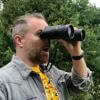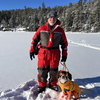Ready to put your Tech Tutors skills into practice? WILDLABS and Freaklabs are proud to announce our new virtual course: Build Your Own Data Logger. This eight-part video tutorial series will guide wildlife and conservation researchers through building and deploying custom hardware using the Arduino platform. To join, Register now!
This course is free to all, but if you would like to build along with the course in real-time, you can purchase the WildLogger board and kit for $30 (USD) here
About the Series
If our first season of Tech Tutors inspired you to put your conservation tech skills to the test, we've got a brand-new experience coming to WILDLABS! Where can you start learning how to use Arduino to build custom devices for wildlife and conservation research? Right here!
Beginning this November, WILDLABS and Freaklabs are proud to introduce an eight-part video tutorial series that guides wildlife and conservation researchers through building and deploying custom hardware using the Arduino platform. The series will use WildLogger - an Arduino-based board that’s designed for deployment - to create a custom data logger.
Are you new to Arduino, or maybe not entirely sure what Arduino is? Good news - this series is for beginners like you! By the end of our eight modules, you'll have the practical skills and knowledge base you need to deploy your creation for real.
The series assumes no hardware experience. It’ll cover common terminology, components, the hardware design stack, setting up the Arduino environment, programming and optimising your application, choosing and modifying enclosures, piloting, testing, deploying and troubleshooting.
You’re not on your own. Our interactive series makes it easier than ever to get feedback and guidance as you learn. Every two weeks, we’ll host a live Office Hours event to troubleshoot, answer questions in person, and release the next module in the series. We'll also have cheat sheets and code to download, plus a forum to ask questions between sessions. And of course, you can build along with the course in real-time with the WildLogger board and kit, available here.
The tutorial is free and allows you to move at your own pace with videos available to all on the WILDLABS Youtube channel. To navigate through all course content, visit the Course Directory.
To join this virtual course, register here!
Group curators
- @Freaklabs
- | He/Him
Freaklabs
I'm an engineer and product designer working in conservation technology. I specialize in technology for landscape restoration and wildlife behavioral ecology.



- 1 Resources
- 307 Discussions
- 20 Groups
Freaklabs
Develops open source technology for wildlife and conservation researchers



- 0 Resources
- 11 Discussions
- 2 Groups
No showcases have been added to this group yet.
- 0 Resources
- 0 Discussions
- 1 Groups
- @kenadyWilson
- | she/her
- 0 Resources
- 0 Discussions
- 8 Groups
Consejo Nacional de Investigaciones Científicas y Técnicas
- 0 Resources
- 5 Discussions
- 3 Groups
Biodiversidata
Uruguayan biologist working in macroecology, biodiversity informatics and environmental education
- 0 Resources
- 0 Discussions
- 1 Groups
- 0 Resources
- 0 Discussions
- 4 Groups
GreenLab


- 0 Resources
- 20 Discussions
- 8 Groups
- @MattyD797
- | He/Him
PhD Student | Cornell University | Smithsonian Institution; My focus is in computational ecology within fishery acoustics


- 0 Resources
- 16 Discussions
- 12 Groups
- @Rewildman
- | He/Him
Eco-entrepreneur. Concerned with the fundamental interconnectedness of all things creative and environmental.
- 0 Resources
- 2 Discussions
- 8 Groups
- @malikmorg
- | He/Him
Software Developer
Interested in all things technology, system design, and hardware, especially in the spaces of conservation, exploration, and the environment.
- 0 Resources
- 0 Discussions
- 10 Groups
- 0 Resources
- 0 Discussions
- 4 Groups
- 0 Resources
- 0 Discussions
- 6 Groups
A chemist by training and enthusiast about the environment by nature. Currently finishing my PhD where I was lucky to merge several of my passions such as programming, data analysis, aquatic ecology and analytical chemistry.
- 0 Resources
- 0 Discussions
- 7 Groups
Welcome to the second part of Build Your Own Data Logger module 3. In these videos, we'll get into the process of writing our data logger application and carrying out our proof-of-concept strategy.
8 January 2021
Welcome to the first part of Build Your Own Data Logger module 3. In these videos, we'll get into the process of writing our data logger application and carrying out our proof-of-concept strategy. In Module 3, we break...
1 January 2021
Welcome to the second module of our Build Your Own Data Logger virtual course. In these videos, we'll cover the steps to installing Arduino and setting up the hardware, as well as writing our first programs.
24 November 2020
Welcome to the first module of our Build Your Own Data Logger virtual course. We'll cover what you need to know about the hardware and software we'll use in this course, and things you should consider when choosing...
10 November 2020
Ready to put your Tech Tutors skills into practice? WILDLABS and Freaklabs are proud to announce our new virtual course: Build Your Own Data Logger. This eight-part video tutorial series will guide wildlife and...
19 October 2020
November 2023
event
January 2023
| Description | Activity | Replies | Groups | Updated |
|---|---|---|---|---|
| An observation I made when first experimenting with DHT22 modules with a Raspberry Pi years ago that still seems true with Arduino and DHT11 sensors. The first reading of... |
|
Build Your Own Data Logger Community | 4 years 6 months ago | |
| @Jeffm Oh that's great to hear. We've had a couple of cable issues so far, but I'm really glad you got the problem sorted. Onward and upward! Akiba... |
+18
|
Build Your Own Data Logger Community | 4 years 7 months ago | |
| Ha ha ha. it will be much more important than that later on. Stay tuned :) Akiba |
|
Build Your Own Data Logger Community | 4 years 7 months ago | |
| Hi Liam. To get the cables through the cable gland, we'll need to remove the wires from the terminal housing and then reinstall them. That will be in a later module... |
|
Build Your Own Data Logger Community | 4 years 7 months ago | |
| Thank you, that's very helpful. Nice to see it is a shortcut. |
|
Build Your Own Data Logger Community | 4 years 7 months ago | |
| Hi everyone, while beeing separated from my Wildlogger board I still had to play with some sensors ;-) Ceck out this wonderful project: https://sensebox.de/en/ Great to learn... |
+2
|
Build Your Own Data Logger Community | 4 years 7 months ago | |
| Hi there! Yes, we're in the process of working out the new schedule - several of the modules have ended up being longer and more in-depth than we originally expected, so we... |
|
Build Your Own Data Logger Community | 4 years 7 months ago | |
| Oh! Okay that's good to know, we'll move the links. |
|
Build Your Own Data Logger Community | 4 years 7 months ago | |
| Ah yes! Rookie mistake and soon as I saw your response I remembered the #include #define needed to be outside the setup. Thank you! |
|
Build Your Own Data Logger Community | 4 years 7 months ago | |
| It would slot in to replace the usual SD storage card, with power, controls and antenna etc. hanging off thin wires -- the idea being to fit as many existing products as possible... |
+5
|
Build Your Own Data Logger Community | 4 years 7 months ago | |
| Hi. I guess we haven't made it prominent enough. Here is the github link where you can find all the code for the virtual course: Link Hope that helps :) Akiba |
|
Build Your Own Data Logger Community | 4 years 7 months ago | |
| @vickiedenicola In your code to set the baud rate you write: cmd.begin(57600); Have you tried this with: Serial.begin(57600); |
+12
|
Build Your Own Data Logger Community | 4 years 7 months ago |































